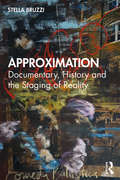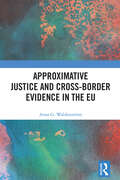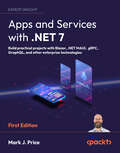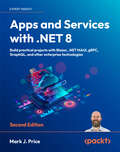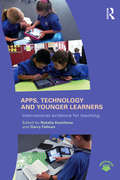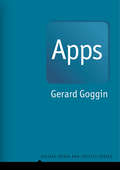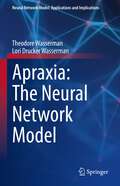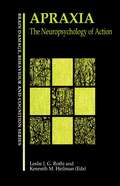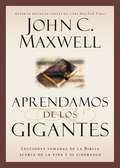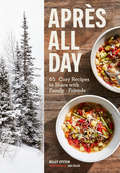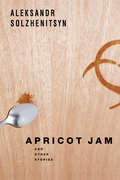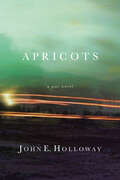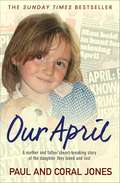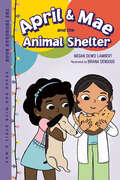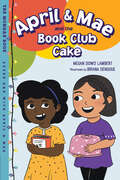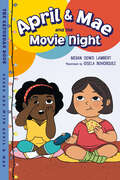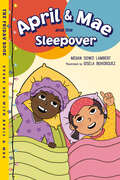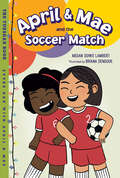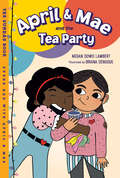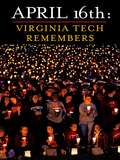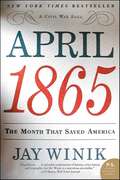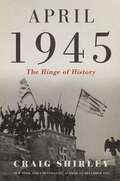- Table View
- List View
Approximation: Documentary, History and the Staging of Reality
by Stella BruzziIn our era of ‘fake news’, Stella Bruzzi examines the dynamism that results from reusing and reconfiguring raw documentary data (documents, archive, news etc.) in creative ways. Through a series of individual case studies, this book offers an innovative framework for understanding how, in our century, film and media texts frequently represent reality and negotiate the instabilities of ‘truth’ by ‘approximating’ factual events rather than merely representing them, through juxtaposing disparate, often colliding, perspectives of history and factual events. Covering areas such as true crime, politics and media, the book analyses the fluidity and instability of truth, arguing that 'approximation' is more prevalent now in our digital age, and that its conception is a result of viewers’ accidental or unconscious connections and interventions. Original and thought-provoking, Approximation provides students and researchers of media, film and cultural studies a deeper insight into our understanding and acceptance of what truth really means today.
Approximative Justice and Cross-Border Evidence in the EU
by Anna G. WaldenströmThis book confronts the difficulties raised by cross-border evidence in order to propose a new understanding of justice as approximative.Can there be any common sense of justice across the European Union (EU)? This book takes up this question which is raised directly in cases where the understanding of cross-border evidence encounters national and linguistic differences. The interpretive challenges this introduces impact the possibility of justice in a way that, the book argues, cannot be resolved with recourse to some ideal of harmonization that would simply flatten these differences. Rather, these cases – taken here from Sweden and France – raise a practical, but also a theoretical, question about how justice can be done. In response, the book draws on contemporary theorizations of justice to argue against a common sense of justice in the sense of what would be a correct legal judgment. In its place, the book elaborates an idea of justice that maintains, rather than collapsing, the differences presented in cases of cross-border evidence; and which therefore aims to be ‘approximative,’ or ‘good enough,’ rather than simply correct.This book will be of interest to readers in legal theory, socio-legal studies, comparative law and European Union law.
Apps and Services with .NET 7: Build practical projects with Blazor, .NET MAUI, gRPC, GraphQL, and other enterprise technologies
by Mark J. PriceBestselling author Mark Price is back to guide you through the coolest and most common technologies a .NET developer should know: Blazor, .NET MAUI, gRPC, GraphQL, SQL Server, Cosmos DB, OData, SignalR, Azure Functions, and more!Purchase of the print or Kindle book includes a free eBook in PDF format.Key FeaturesBuild services using a variety of technologies including Web API, OData, gRPC, GraphQL, SignalR, and Azure FunctionsLearn how to use specialized libraries to improve all aspects of your applications, including performance and localizationLeverage .NET MAUI to develop cross-platform desktop and mobile apps with easeBook DescriptionApps and Services with .NET 7 is for .NET 6 and .NET 7 developers who want to kick their C# and .NET understanding up a gear by learning the practical skills and knowledge they need to build real-world applications and services. It covers specialized libraries that will help you monitor and improve performance, secure your data and applications, and internationalize your code and apps.With chapters that put a variety of technologies into practice, including Web API, OData, gRPC, GraphQL, SignalR, and Azure Functions, this book will give you a broader scope of knowledge than other books that often focus on only a handful of .NET technologies. It covers the latest developments, libraries, and technologies that will help keep you up to date.You'll also leverage .NET MAUI to develop mobile apps for iOS and Android as well as desktop apps for Windows and macOS.What you will learnLearn how to build more efficient, secure, and scalable apps and servicesLeverage specialized .NET libraries to improve your applicationsImplement popular third-party libraries like Serilog and FluentValidationBuild cross-platform apps with .NET MAUI and integrate with native mobile featuresGet familiar with a variety of technologies for implementing services like gRPC and GraphQLExplore Blazor WebAssembly and use open-source Blazor component librariesStore and manage data locally and in the cloud with SQL Server and Cosmos DBWho this book is forThis book is for .NET developers interested in exploring more specialized libraries and implementation fundamentals behind building services and apps.You'll need to know your way around .NET and C# quite well before you can dive in, so if you want to work your way up to this book, pick up Mark's other .NET book, C# 11 and .NET 7 – Modern Cross-Platform Development Fundamentals, first.
Apps and Services with .NET 8: Build practical projects with Blazor, .NET MAUI, gRPC, GraphQL, and other enterprise technologies
by Mark J. PriceBestselling author Mark Price is back to guide you through the latest and most common technologies a .NET developer should know: Blazor Full Stack, ASP.NET Core MVC, ASP.NET Core Minimal APIs, .NET MAUI, gRPC, GraphQL, SQL Server, Cosmos DB, SignalR, Azure Functions, and more! Purchase of the print or Kindle book includes a free eBook in PDF format.Key FeaturesUse specialized libraries to improve all aspects of your apps, including performance, security, and localizationHarness the full potential of .NET using cloud-native data stores like Cosmos DB, and unlock scalability, performance, and resilience in your service implementationsUnleash the capabilities of Blazor Full Stack and.NET MAUI to develop stunning, truly cross-platform apps for web and mobileBook DescriptionElevate your practical C# and .NET skills to the next level with this new edition of Apps and Services with .NET 8. With chapters that put a variety of technologies into practice, including Web API, gRPC, GraphQL, and SignalR, this book will give you a broader scope of knowledge than other books that often focus on only a handful of .NET technologies. You’ll dive into the new unified model for Blazor Full Stack and leverage .NET MAUI to develop mobile and desktop apps. This new edition introduces the latest enhancements, including the seamless implementation of web services with ADO.NET SqlClient's native Ahead-of-Time (AOT) support. Popular library coverage now includes Humanizer and Noda Time. There’s also a brand-new chapter that delves into service architecture, caching, queuing, and robust background services. By the end of this book, you’ll have a wide range of best practices and deep insights under your belt to help you build rich apps and efficient services.What you will learnFamiliarize yourself with a variety of technologies to implement services, such as gRPC and GraphQLStore and manage data locally and cloud-natively with SQL Server and Cosmos DBUse ADO.NET SqlClient to implement web services with native AOT publish supportLeverage Dapper for improved performance over EF CoreImplement popular third-party libraries such as Serilog, FluentValidation, Humanizer, and Noda TimeExplore the new unified hosting model of Blazor Full StackWho this book is forThis book is for .NET developers interested in exploring more specialized libraries and implementation fundamentals behind building services and apps. You’ll need to know your way around .NET and C# quite well before you can dive in, so if you want to work your way up to this book, you can pick up Mark’s other .NET book, C# 12 and .NET 8 – Modern Cross-Platform Development Fundamentals, first.
Apps, Technology and Younger Learners: International evidence for teaching
by Natalia Kucirkova Garry FalloonThis book provides an in-depth analysis of the challenges, potential and theoretical possibilities of apps and considers the processes of change for education and home learning environments. Drawing together a diverse team of international contributors, it addresses the specific features, context of use and content of apps to uncover the importance of these tools for young children’s learning. Apps, Technology and Younger Learners focuses on ways that apps support early years and primary school learning, connect various learning spaces and engage children in a range of edutainment and knowledge-building activities. In each chapter, the current state of knowledge and key research questions in the field for future study are identified, with clear messages provided at the end of each chapter. Focusing on empirical studies and strong theoretical frameworks, this book covers four key parts: Understanding the learning potential of children’s apps; Key app challenges; Empirical evidence; Future avenues. This book is an essential guide for educators, post-graduate students, researchers and all those interested in the advantages or challenges that may result from integrating apps into early education.
Apps: From Mobile Phones to Digital Lives (Digital Media and Society)
by Gerard GogginSince the rise of the smartphone, apps have become entrenched in billions of users' daily lives. Accessible across phones and tablets, watches and wearables, connected cars, sensors, and cities, they are an inescapable feature of our current culture. In this book, Gerard Goggin provides a comprehensive and authoritative guide to the development of apps as a digital media technology. Covering the technological, social, cultural, and policy dynamics of apps, Goggin ultimately considers what a post-app world might look like. He argues that apps represent a pivowtal moment in the development of digital media, acting as a hinge between the visions and realities of the “mobile,” “cyber,” and “online” societies envisaged since the late 1980s and the imaginaries and materialities of the digital societies that emerged from 2010. Apps offer frames, construct tools, and constitute “small worlds” for users to reorient themselves in digital media settings. This fascinating book will reframe the conversation about the software that underwrites our digital worlds. It is essential reading for students and scholars of media and communication, as well as for anyone interested in this ubiquitous technology.
Apraxia: The Neural Network Model (Neural Network Model: Applications and Implications)
by Lori Drucker Wasserman Theodore WassermanThe work will be a reanalysis and reconceptualization of the concept of apraxia. Apraxia is currently understood as a motor speech disorder but an analysis of the neural network properties of apraxia indicate a more complex and far reaching disorder with implications for intentionality, motor coordination and motor control of response inhibition in a variety of human behavioral and emotional reactions. A thorough redefinition of apraxia will be provided along with suggestions for diagnoses and treatment. The primary audience will be diagnostic and treating professionals in a variety of disciplines (outlined above). Secondarily, the book will provide an argument and justification for considering developmental apraxia pf speech to be a separate and discrete white matter based disorder. Finally, this work will serve as a driver of future research in the area.
Apraxia: The Neuropsychology of Action (Brain, Behaviour and Cognition)
by Kenneth M. Heilman Leslie J. Gonzalez RothiThe purpose of this book is to provide the reader with a perspective on apraxia that considers a link between the pathology of apraxia and normal motor skill. In addition, it is the intention of the authors to provide information that is theoretically interesting as well as clinically applicable. The book is a collection of papers by various authors working in the area of apraxia, almost exclusively with limb aparaxia specifically. Beginning with Hugo Liepman's work of the late 19th century, a cognitive neuropsychological model of limb apraxia is reviewed, the use of new technologies that are informative about the mechanisms of limb praxis are discussed, and issues related to research as well as clinical assessment/management of the disorder are provided. While acquired limb apraxia is the focus of the book, there are also chapters on handedness, developmental apraxia of speech, and disorders of handwriting.
Aprendamos de los Gigantes: Lecciones Tomadas de la Biblia Acerca de la Vida y el Liderazgo (Giants of the Bible)
by John C. MaxwellSi pudieras pasar tiempo en persona con los gigantes de la fe del Antiguo Testamento, ¿cómo sus percepciones afectarían tu vida? En este libro, John Maxwell se basa en más de cincuenta años estudiando la Biblia para transmitir la valiosa sabiduría de Elías, Eliseo, Job, Jacob, Débora, Isaías, Jonás, Josué y Daniel: Job forjó su fortaleza de carácter y se mostró optimista mientras se enfrentaba a una gran pérdida. Su reto para ti es: "¿Puedes mantenerte siendo positivo y fiel cuando las circunstancias son abrumadoras?"Débora fue escogida por Dios para ser una líder en un momento difícil. Ella te invita a que vuelvas a imaginar la envergadura de tu potencial: "Dios quiere sorprender al mundo a través de ti".Maxwell explora las historias notables de estos nueve héroes de la fe para compartir las lecciones eternas que puedes descubrir en cada una de ellas. Asimila sus experiencias y utiliza las preguntas de discusión para aprender sobre el liderazgo, sobre ti mismo y tu relación con Dios. La sabiduría que estos héroes comparten te ayudará a superar los retos de hoy.
Apres All Day: 65+ Cozy Recipes to Share with Family and Friends
by Kelley EpsteinFor ski bums and non-skiers who enjoy the snow, here is a cozy winter cookbook of 65+ hearty recipes, plus beautiful photography that captures the après-ski culture and mountain town life.Après-ski is more than just an afternoon beer in the lodge. It's an opportunity to gather with friends and family over delicious food and drinks during the cold winter months. This cozy cookbook invites home cooks of all levels to embrace the après culture all season long, whether they're the first skier on the slopes in the morning or a nonskier who prefers to snuggle up by the fireplace. There are recipes for every meal—because yes, you really can "après all day"—including Apple Pie Oatmeal as pre-ski fuel, Tater Tot Nachos, a.k.a. "Tatchos" for an indulgent snack on the couch, Classic Beef Stew with Cheesy Garlic Bread for a family potluck, and a well-deserved Kitchen Sink Skillet Cookie to end the day. There is a section with helpful tips on cooking at altitude, plus fun sidebars featuring must-know ski lingo, ideas for game night, and more. Ski bums, outdoor enthusiasts, and anyone who lives in cold climates will appreciate the hearty recipes and beautiful photography of mountain scenery.FOR ANYONE IN COLD CLIMES: Après-ski isn't just for skiers, and neither is this cookbook—anyone can après, at any time of day! The recipes in this book are perfect for anyone who lives somewhere with cold winters or loves the mountains or the idea of mountain living.GOOD GIFT FOR A RANGE OF FOLKS: With beautiful mountain scenery and photos of charming ski towns, Après All Day encapsulates a way of life. This is a lovely gift for anyone who likes to cook, as well as those who enjoy or aspire to an outdoorsy life in the mountains.COMPELLING PACKAGE: Après All Day is full of evocative photography: a stack of blankets, signage on the slopes, chairlifts in the fog, snow-dusted pine trees, and more. The approachable recipes, informal tone, and aspirational photography will make you feel as if you are enjoying a ski weekend in the mountains with your best friend.Perfect for:• Home cooks who love the mountains and mountain dwellers who like to cook• Skiers and snowboarders of all levels• Anyone who enjoys snow activities and the après-ski culture• Those who live in places with cold winters• Armchair travelers
Apricot Jam And Other Stories: And Other Stories (Canons Ser. #97)
by Aleksandr SolzhenitsynAfter years of living in exile, Aleksandr Solzhenitsyn returned to Russia in 1994 and published a series of eight powerfully paired stories. These groundbreaking stories- interconnected and juxtaposed using an experimental method Solzhenitsyn referred to as "binary"-join Solzhenitsyn's already available work as some of the most powerful literature of the twentieth century.With Soviet and post-Soviet life as their focus, they weave and shift inside their shared setting, illuminating the Russian experience under the Soviet regime. In "The Upcoming Generation," a professor promotes a dull but proletarian student purely out of good will. Years later, the same professor finds himself arrested and, in a striking twist of fate, his student becomes his interrogator. In "Nastenka," two young women with the same name lead routine, ordered lives-until the Revolution exacts radical change on them both.The most eloquent and acclaimed opponent of government oppression, Solzhenitsyn was awarded the Nobel Prize in Literature in 1970, and his work continues to receive international acclaim. Available for the first time in English, Apricot Jam: And Other Stories is a striking example of Solzhenitsyn's singular style and only further solidifies his place as a true literary giant.
Apricots on the Nile: A Memoir with Recipes
by Colette RossantCairo, 1937: French-born Colette Rossant is waiting out World War II among her father's Egyptian-Jewish relatives. From the moment she arrives at her grandparents' belle époque mansion by the Nile, the five-year-old Colette finds companionship and comfort among the other "outsiders" in her home away from home -- the cooks and servants in the kitchen. The chef, Ahmet, lets Colette taste the ful; she learns how to make sambusaks for her new friends; and she shops for semits and other treats in the Khan-al-Khalili market. Colette is beginning to understand how her family's culture is linked to the kitchen...and soon she will claim Egypt's food, landscape, and people as her own. Apricots on the Nile is a loving testament to Colette's adopted homeland. With dozens of original recipes and family photographs, Colette's coming-of-age memoir is a splendid exploration of old Cairo in all its flavor, variety, and wide-eyed wonder.
Apricots: A War Novel
by John E Holloway John HollowayLieutenant Robert Forrest joined the Marines because his father was a Marine. His whole life he felt the pull of patriotism rooted in his Marine Corps upbringing. But after the Vietnam war, he doubts the Country he&’s sworn to serve. The collapse of the Republic of Vietnam in 1975 confirmed defeat of the U.S. – and the wasted sacrifice of 58,000 American lives. Getting killed for a lost cause in an unnecessary War is Forrest&’s greatest fear. In 1983, eight years after Saigon fell, Lieutenant Robert Forrest leads a Marine platoon bound for Beirut. Along the way, the Marines invade Grenada and then move on to Beirut. Can Forrest reconcile his service with his doubts? Will the Marines all make it out alive? Or will Forrest&’s worst fears be realized? Set against the backdrop of a post-Vietnam world, Apricots tells the harrowing story of one Lieutenant and his platoon as they fight in Grenada, the last Combat of the Cold War, and then move onto Beirut to fight the first battles in the War on Terror.
April
by Paul JonesIn October 2012, the nation was gripped by the tragic story of five-year-old April Jones, whose disappearance from the tiny Welsh village of Machynllech sparked the biggest police search in UK history. Her body was never fully recovered but paedophile Mark Bridger was convicted of her murder and abduction following a month-long trial in May 2013. In this gripping and harrowing book, April's heartbroken parents Coral and Paul speak at length about their beloved daughter and the search for her, their ordeal as they faced Bridger in court every day during the trial, and their ongoing fight against the vile child pornography he viewed in the days leading up to April's abduction. They remember with enduring love the daughter who fought so bravely to survive premature birth and mild disability, and who was enchanted by all the things a little girl finds magical. Paul Jones kept a diary throughout the ordeal, the contents of which are revealed for the first time in this searingly honest account of unimaginable emotional pain. Alongside books such as Madeleine by Kate McCann and Goodbye Dearest Holly by Kevin Wells, April will stand as a poignant reminder of what it means to lose the thing you most love.
April & Mae and the Animal Shelter: The Thursday Book (Every Day with April & Mae #5)
by Megan Dowd LambertFans of King & Kayla and Charlie & Mouse will love this delightful beginning chapter book series that celebrates friendship every day of the week!It's Thursday, and April and Mae want to help the new animal shelter. Mae is good at helping with her hands, and April is better at helping with her words. While Mae plans a lemonade stand to raise money for cat food, April writes a letter to the newspaper encouraging pet adoption but wonders whether that will help. Mae helps her to see that even little actions can contribute to change bit by bit! With imagination and humor, Every Day with April & Mae brings all there is to know and love about friendship to life in a way kids can both relate to and learn from making this a perfect fit for young readers ready to step up from picture books.
April & Mae and the Book Club Cake: The Monday Book (Every Day with April & Mae #2)
by Megan Dowd LambertFans of King & Kayla and Charlie & Mouse will love this delightful beginning chapter book series that celebrates friendship every day of the week!It&’s Monday, and April and Mae aren't prepared for book club. To save time, April reads the book aloud while Mae bakes a cake for their friends. When they forget to add flour, some quick thinking helps the girls salvage the dessert. Sometimes a mistake can turn into something better than the original plan! With imagination and humor, Every Day with April and Mae brings all there is to know and love about friendship to life in a way kids can both relate to and learn from making this a perfect fit for young readers ready to step up from picture books.
April & Mae and the Movie Night: The Saturday Book (Every Day with April & Mae #7)
by Megan Dowd LambertFans of King & Kayla and Charlie & Mouse will love this delightful beginning chapter book series that celebrates friendship every day of the week!It&’s Saturday, and April and Mae are having movie night. Mae gets pineapple on the pizza because April likes it, and April chooses a scary movie because Mae will like it. When the movie ends up being too scary for April, the girls realize that they don't have to like all the same things as long as they like each other! With imagination and humor, Every Day with April & Mae brings all there is to know and love about friendship to life in a way kids can both relate to and learn from making this a perfect fit for young readers ready to step up from picture books.
April & Mae and the Sleepover: The Friday Book (Every Day with April & Mae #6)
by Megan Dowd LambertFans of King & Kayla and Charlie & Mouse will love this delightful beginning chapter book series that celebrates friendship every day of the week!It's Friday, and April and Mae are having a sleepover. April wants to camp in her backyard, but Mae isn't so sure about sleeping outside. Can the friends come to a compromise? April works hard to make the tent comfy with blankets and pillows, and Mae gets on board telling a scary story and watching the stars. With imagination and humor, Every Day with April & Mae brings all there is to know and love about friendship to life in a way kids can both relate to and learn from making this a perfect fit for young readers ready to step up from picture books.
April & Mae and the Soccer Match: The Tuesday Book (Every Day with April & Mae #3)
by Megan Dowd LambertFans of King & Kayla and Charlie & Mouse will love this delightful beginning chapter book series that celebrates friendship every day of the week!It&’s Tuesday, at the soccer game! April likes to play soccer, and Mae likes to win. When a slip in the mud causes Mae to miss the winning goal, she's frustrated. But best friend April helps Mae see that one loss doesn&’t make her bad at soccer and reminds her that playing with friends is just as fun as winning. With imagination and humor, Every Day with April and Mae brings all there is to know and love about friendship to life in a way kids can both relate to and learn from making this a perfect fit for young readers ready to step up from picture books.
April & Mae and the Talent Show: The Wednesday Book (Every Day with April & Mae #4)
by Megan Dowd LambertFans of King & Kayla and Charlie & Mouse will love this delightful beginning chapter book series that celebrates friendship every day of the week!It&’s Wednesday, and the library is holding a talent show to raise money for new books. April and Mae want to help. April decides to perform, but Mae prefers to help behind the scenes. When April gets nervous on the day of the show, Mae's support is all she needs to overcome her fears! With imagination and humor, Every Day with April and Mae brings all there is to know and love about friendship to life in a way kids can both relate to and learn from making this a perfect fit for young readers ready to step up from picture books.
April & Mae and the Tea Party: The Sunday Book (Every Day with April & Mae #1)
by Megan Dowd LambertFans of King & Kayla and Charlie and Mouse will love this delightful beginning chapter book series that celebrates friendship every day of the week!It's Sunday, and April and Mae are having their weekly tea party. Mae usually bakes goodies, and April always sings and dances. But this Sunday, April decides to try a new activity. When April's juggling causes her to break Mae's favorite teacup, the two friends navigate their first disagreement and eventually apologize and forgive each other. With imagination and humor, Every Day with April and Mae brings all there is to know and love about friendship to life in a way kids can both relate to and learn from making this a perfect fit for young readers ready to step up from picture books.
April 16, 2007: Virginia Tech Remembers
by Virginia Tech CommunityOn April 16, 2007 Virginia Tech in Blacksburg Virginia was changed forever when a student took the lives of 32 students and wounded a dozen more before taking his own life. Student reporters went right along with the pros asking the tough questions and interviewing some of the families to gain an understanding of this event so they themselves could find some peace and reassurance that this wouldn't happen again. Memorials are included of all those who lost their lives including a Holocaust survivor who risked his life on April 16th to save the lives of his students and a Lebanese American who had just spent the summer in Lebanon and barely escaped with her life from a country under attack, only to be at Virginia Tech on that tragic day.
April 16th: Virginia Tech Remembers
by Roland LazenbyA gripping, emotional account of the worst school shooting in United States history, told by those who lived through it Monday, April 16, 2007 started like any other Monday at Virginia Tech, with professors and students preparing for another busy week of classes. However, word quickly circulated of a shooting in the dorms - and the gunman was still loose. The campus went into lockdown, and as the gruesome events unfolded in Norris Hall, a group of journalism students trapped in a nearby building transmitted stories and updates to the student-run website, PlanetBlacksburg.com. Now, these students, together with their journalism instructor and members of the Virginia Tech community, have documented the events of that day. April 16th: Virginia Tech Remembers gives a voice to the students, faculty, and staff who lived through the shooting, and serves as a memorial for the 32 victims. The book also describes the onslaught of media coverage that immediately followed, and reveals the remarkable resilience of the students of Virginia Tech throughout the entire ordeal.
April 1865: The Month That Saved America (Civil War Sagas)
by Jay WinikOne month in 1865 witnessed the frenzied fall of Richmond, a daring last-ditch Southern plan for guerrilla warfare, Lee's harrowing retreat, and then, Appomattox. It saw Lincoln's assassination just five days later and a near-successful plot to decapitate the Union government, followed by chaos and coup fears in the North, collapsed negotiations and continued bloodshed in the South, and finally, the start of national reconciliation.In the end, April 1865 emerged as not just the tale of the war's denouement, but the story of the making of our nation.Jay Winik offers a brilliant new look at the Civil War's final days that will forever change the way we see the war's end and the nation's new beginning. Uniquely set within the larger sweep of history and filled with rich profiles of outsize figures, fresh iconoclastic scholarship, and a gripping narrative, this is a masterful account of the thirty most pivotal days in the life of the United States.
April 1945: The Hinge of History
by Thomas NelsonAcclaimed historian and New York Times bestselling author Craig Shirley delivers a compelling account of 1945, particularly the watershed events in the month of April, that details how America emerged from World War II as a leading superpower.In the long-awaited follow-up to the widely praised December 1941,Craig Shirley's April 1945 paints a vivid portrait of America--her people, faith, economy, government, and culture. The year of 1945 bought a series of watershed events that transformed the country into an arsenal of democracy, one that no longer armed the world by necessity but henceforth protected the world by need.At the start of 1945, America and the rest of the world were grieving millions of lives lost in the global conflict. As President Roosevelt was sworn into his fourth term, optimism over an end to the bloody war had grown--then, in April, several events collided that changed the face of the world forever: the sudden death of President Roosevelt followed by Harry S. Truman's rise to office; Adolph Hitler's suicide; and the horrific discoveries of Dachau and Auschwitz. Americans doubled down on their completion of the atomic bomb and their plans to drop them on Hiroshima and Nagasaki, the destruction ultimately leading the Japanese Empire to surrender on V-J day and ending World War II for good.Combining engaging anecdotes with deft research and details that are both diminutive and grand, April 1945 gives readers a front-row seat to the American stage at the birth of a brand-new world.
